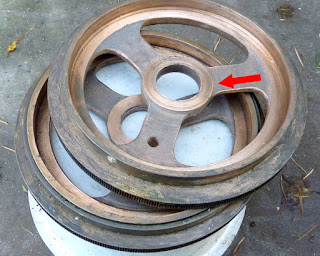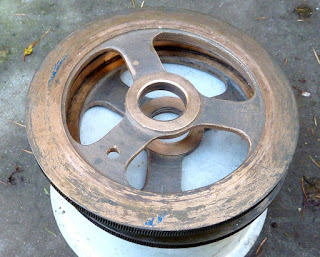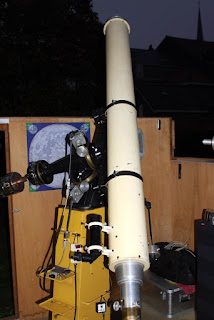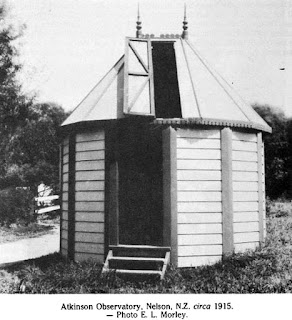*

I dismantled the MkIV mounting to be able to work more easily on replacing the bent and rusty, drive control rods. The Dec shaft came out easily enough but the Polar Axis shaft was firmly stuck. When I finally removed it I found that it had not been inserted deeply enough into the Dec casting. My own fault for not marking it prior to insertion when I changed the rust-prone shafts to [featureless] stainless steel.
After carefully measuring the depth of the hole and marking the shaft I used a block of wood and a lump hammer to drive the shaft fully home. I re-cut the holding screw threads with a 5/16BSW tap after spotting through the screw holes with a center punch. Then I drilled a shallow pit for each pointed screw on opposite sides of each shaft for the fixing bolts to get a good grip on the shaft. I don't think there is any danger of a shaft falling out now. The image above shows the nylon plug which presses against the rim inside the annular section of the wormwheel. The thin sheet of PTFE/Teflon is to reduce friction. One of the shaft fixing screws is visible jutting from the casting just above the new, slanting, stainless steel, threaded, drive control rod.
My only 5/16BSW tap had a very long taper. This proved unable to reach deep enough with a fully formed thread with the 1.25" shaft still in place. So now I had to undo yesterday's hammering to get the shaft out again! I decided to bring my biggest vice into play. The shaft was inserted into a thin-wall steel tube for protection from the vice jaws. I could now use the lump hammer against a large stump of timber with an angle cut on one end. The wood had to hit the flat face of the casting squarely without damage from the hammering. The angled end ensured the maximum area was being struck to avoid damage without hitting the shaft. Fortunately the mark I had made on the shaft reversed steadily away from the casting face and I was eventually able to remove the shaft without damage.

Now I could cut the locking screw thread to full depth and check [repeatedly] that the pointed screw just broke into the bore in the casting without looseness. The casting alloy is very soft and there was no point in making the thread any deeper than necessary. The shaft was then hammered back in using another block of wood to avoid damaging the end. The upshot of all this work is that I now have two opposing screws to fix the polar shaft very safely in place without any offset force from only one fixing screw.
My next discovery was that the Declination wormwheel had been badly machined at the time of manufacture. The hub of the 7" spoked, bronze casting seemed never to have been turned to the correct height. Not only was it 1mm higher than the rim but the face of the boss was visibly sloping!! An oversight which has gone unnoticed for probably 50 years. The real clue was in the raised hump in the center of the PTFE, low friction disk. The vital rim bearing showed no rubbing
at all on the white plastic disk. While the polar disk showed even wear to both center and rim rubbing surfaces. Measurement with vernier calipers showed the center boss was fully, 1mm higher than the rim. Which meant that the declination axis had never enjoyed the plate bearing support provided for in the brilliant initial design.
The first cut, with the 180mm, 7" 359 tooth wormwheel in the 4-jaw chuck of the lathe, immediately confirmed the sloping surface of the hub. [See image] It took several cuts just to get a clean surface all over the boss. Only then could I measure the relative levels of the bearing rim and the center boss. Once I had some idea of the amount of material to be removed I set the speed up considerably to avoid chatter marks. finally I gave a cut across the back of the wormwheel to take out an obvious warp!
I am supposing that, ideally. the boss and rim should be level on both sides of the wormwheel. This would provide the best bearing effect of low friction from the smaller diameter boss. While still retaining the stability of the much larger, but more lightly loaded, rim thrust surface.
The rim thrust bearing can be thought of as similar to a Dobsonian ground board and rocker box. The large circle formed by the bearing tab's radius ensures adequate friction with great stability against tipping. A complete lack of friction is usually undesirable in a telescope mounting. It demands perfect balance in all planes and is easily affected by the slightest breeze or touch. A low, but unchanging, degree of friction makes handling the telescope much more pleasant and relaxed. The clever Dobson mounting used suitable materials to achieve this without needing precision machined surfaces or absolute rigidity. Allowing a gentle nudge to track an object. Or providing the necessary resistance to allow focusing or changing eyepieces without instantly losing the object.

The flat faces of the MkIV's castings add their own stiffness to the axis shafts. An idea attributed to Russel W Porter in his Springfield [plate and pin] mounting but also used on much earlier mountings. The flat bearing faces greatly resist bending loads applied to the shafts. To maximize this effect the rims of the plates must bear at least some of the load.
The mechanical
disadvantage applied to the rims is at a much larger diameter than the bearings on the shaft. Separating the bearing faces, at an angle, is rather like trying to lift something heavy by pushing down on the short end of a long lever. This makes it very difficult for the flat faces to separate against the applied weight of the telescope, heavy mounting parts and the counterweights.
The MkIV always had a reputation for being able to support far heavier instruments than might be imagined from its quite modestly sized 1.25" shafts. The increased strength can only have come from the flat/plate bearing faces. Fullerscopes introduced a very thin PTFE sheet between the load bearing faces to reduce friction over the large area involved. The thin sheet provided no additional flexibility. So the [highly desirable] intimate fit between the flat bearing faces was maintained.

Adding slow motion wormwheels might have undone the MkIV designer's genius in applying plate and shaft bearings in combination. However, the designer ensured the greatest diameter carried the major loads by introducing a hidden, internal, thrust rim. This protected rubbing surface could not be easily contaminated. The thin, PTFE sheet was now placed between the wormwheels and the flat face to maintain low friction. In an un-driven MkIV the PTFE sheet would go between the flat, aluminium casting faces.
The wormwheels are essentially fixed [by their driving worms] when the telescope is slewed. So the moving friction face is now between the wormwheel rim and the flat bearing face.
NOT between the underside of the wormwheel and the next plate bearing face. The underside of the wormwheel surface only ever moves at the incredibly slow equatorial or declination drive rate. As can be easily seen by the complete lack of wear to the lacquer I applied to the back of the declination slow motion wormwheel. I rarely used the reversible, motor driven, declination slow motion for visual use so no wear has taken place over the years. Conversely the arrowed rear rim does show wear on the RA wormwheel in the image below. One can safely assume that the rim bearings are working as intended on the polar axis.

There are no "naked" shaft overhangs anywhere in the MkIV's clever design. Many mountings have long lengths of exposed shaft which must inevitably put all the bending loads onto the shaft itself with considerable leverage. The worst possible situation is between the north bearing of the Polar Axis and the declination 'T' casting. Or between the mounting saddle and its nearest bearing.
The MkIV also has bronze shell bearings pressed into the castings. These provide direct connection to the stiffness of the castings without the unwanted freedom introduced by journal bearings.
The MkIV's axis castings are conical. With the bearings carrying the highest loads centered in the large round flat faces which act as strengthening flanges. The loads are carried into the casting over a very large area further reducing the chance of flexure. The much lighter loaded ends of the castings are much reduced in diameter because they do not need to be otherwise.
One means by which the MkIV could be improved further would be stepped or [better] tapered shafts. With a larger bearing at the "fat" end of the castings where most of the loads are concentrated. However, this modification requires a number of changes. The saddle and declination 'T' castings would need to be bored oversize to maximize use of the increased shaft stiffness. Though these bores could remain at 1.25" with a larger diameter sleeve fixed over the original shaft. The fit of the sleeve would have to be perfect and firmly fixed to have any value. Industrial adhesive would probably do the job if the sleeve would not be hydraulically pressed over the shaft. The shoulder of the step in the shaft must butt up tightly against the casting which that shaft supports. Otherwise the increased shaft stiffness is lost at the precise point where the greatest loads are applied.
The introduction of journal bearings might actually undo some of the MkIV's best qualities. Ball or roller bearings would probably only be necessary at the fat ends of the castings. The smaller ends carry much lighter loads and would not benefit from lower friction bearings. Adding taper roller, or other linear load bearings might actually undo all the advantages of the plate bearings! It would require very fine adjustment of any linear bearings to avoid undermining the plate bearing's added stiffness. Friction might be usefully reduced but must not be at the expense of stability provided by the large bearing surface areas.

The one, major Achilles Heel of the MkIV is the polar altitude adjustment. The conical polar casting is pivoted in the forked base casting. Two "ears" carry bolts which are threaded into the polar casting. The altitude pivot, obviously, cannot pass right through the polar shaft. So two short pivot bolts are the only way to carry the entire weight of the mounting, counterweights and telescope into the base and pier.
The original pivot holes on my MkIV were horribly off center by well over 1/2". These holes must have been drilled without any reference or jig. Meaning that the conical polar casting was badly skewed between the supporting fork once the bolts were fitted.
Considerable work, with a large, coarse, round file eventually "moved" both holes over to the correct position. The now very badly over-sized holes needed to be drilled to size and then re-threaded in a larger size. The problem now was the complete lack of coarse threaded, altitude pivot bolts available in Denmark. So I used a larger metric tap and stainless steel bolts but the thread was too fine for a serious grip in the soft casting material. I tried packing inside the ears but that just reduced desirable clamping friction. In the end I needed a turn buckle just to maintain the correct polar altitude. The silly little, altitude locking screws have no grip whatsoever!

The polar casting is hollow so a bolt might be dropped through the bearing hole and then maneuvered sideways through the altitude pivot hole. A nut could then be used on the outside of the ears/fork tines to apply as much pressure as needed or desired. The problem is the difficulty of getting a large bolt to turn inside the casting to get it to pass through the fork tine from the inside. No spanner would fit through the sleeve bearing so an extended hex socket key would be necessary. It just seems far too crude a method of overcoming the MkIV's weakness in this area. A hex socket head bolt does have the advantage of a relatively small head if I should decide to follow this route. Though the very small diameter head would put large local loads on the casting.
Making a new, forked base out of seriously thick aluminium, or even steel, does not overcome the need for these two, short bolts to carry the entire mounting and telescope. Drilling large offset holes beside the originals, to aid placement of bolts from inside the casting, seems rather unkind to such an old and venerable mounting. One might as well build a whole new polar housing as well. If the polar housing was made square in cross section it could have a removable top plate to allow internal access for fitting large, polar altitude, pivot bolts. The MkIV's appearance would be changed drastically. So why stop there? One might as well start all over again building a new mounting from scratch!
Click on any image for an enlargement.
*

 A ridged, bell ended observatory at a UK public [fee paying] school housing an antique 4" or 5" refractor. This design has the advantage of not needing spherical gores. Though room for the refractor dewshield is more limited [than a dome] up at the peak. Suggesting that it be made slightly taller to compensate.
A ridged, bell ended observatory at a UK public [fee paying] school housing an antique 4" or 5" refractor. This design has the advantage of not needing spherical gores. Though room for the refractor dewshield is more limited [than a dome] up at the peak. Suggesting that it be made slightly taller to compensate. Skilled, metal roofing workers still exist in Denmark [and elsewhere no doubt] and are known as blikkenslager here. Tin smiths or even tin beaters are usually employed for making metal roof flashing, decorative roof ornaments and dormers. I wonder how much it would cost to employ a tradesman to construct a strong and weather proof shell of this form out of aluminium? It would almost certainly be cheaper than any commercial dome in the 12' size. A skeleton of square or rectangular, aluminium tube would greatly reduce the weight and extend the lifetime compared with the traditional, deep plywood ribs. Not to mention the tubing's smaller section providing rather more space inside.
Skilled, metal roofing workers still exist in Denmark [and elsewhere no doubt] and are known as blikkenslager here. Tin smiths or even tin beaters are usually employed for making metal roof flashing, decorative roof ornaments and dormers. I wonder how much it would cost to employ a tradesman to construct a strong and weather proof shell of this form out of aluminium? It would almost certainly be cheaper than any commercial dome in the 12' size. A skeleton of square or rectangular, aluminium tube would greatly reduce the weight and extend the lifetime compared with the traditional, deep plywood ribs. Not to mention the tubing's smaller section providing rather more space inside.